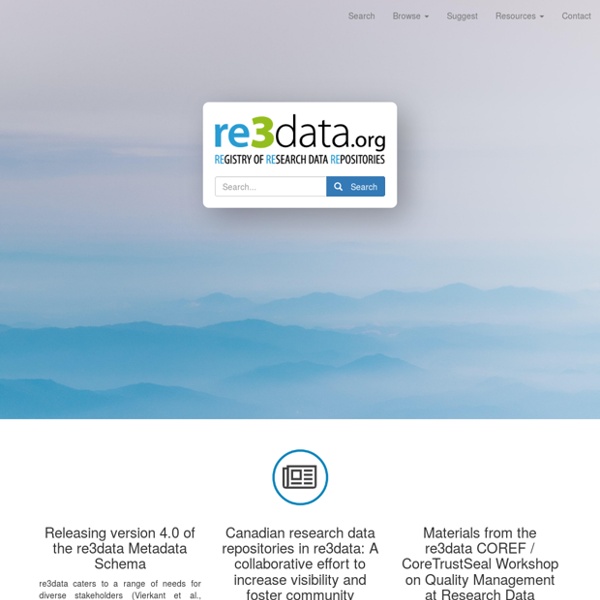



Veille Administration électronique & Données publiques Open data : les syndicats de magistrats réclament le retrait du projet de décret 07/02/2020 - www.actualitesdudroit.fr Des magistrats demandent le retrait du projet de décret relatif à la mise en œuvre de l’open data des décisions de justice. Retour sur les points de blocage et les contre-propositions précises. Article rédigé par G. Marraud des Grottes China Biographical Database Project (CBDB) Social network analysis (SNA) provides an alternative to the factor-based approach in L. Stone's discussion of prosopography. Charles Wetherell writes: “Conceptualizing community as collections of personal relationships … provides historians with a blueprint for evaluating when, how and why people in the past used kin and non-kin in the course of their lives. The findings of social network analysts that people need and seek emotional and economic support of different kinds, from different kinds of people, suggest new analytical imperatives. It is not enough now to look solely at how people used kin in times of crisis.
BASE - Bielefeld Academic Search Engine BASE is one of the world's most voluminous search engines especially for academic web resources. BASE provides more than 200 million documents from more than 8,000 content providers. You can access the full texts of about 60% of the indexed documents for free (Open Access). Casier judiciaire national : fichier statistique Retour à la liste des sources Le casier judiciaire est un fichier des condamnations pénales prononcées par les autorités judiciaires à l’encontre des personnes physiques et morales, et enregistrées par le service du casier judiciaire national. Il est constitué de trois tables : la table des événements comprend l’ensemble des décisions afférentes à l’année N enregistrées par le Casier judiciaire au cours des mois suivants ; la table des mesures énumère l’ensemble des mesures accompagnant la décision prise par l’autorité judiciaire ; la table des infractions décrit l’ensemble des infractions (la principale et les associées) reliées à chacun des événements. Années : 1994, 1995, 1996, 1997, 1998, 1999, 2000, 2001, 2002, 2003, 2004, 2005, 2006, 2007, 2008, 2009, 2010, 2011, 2012, 2013, 2014, 2015, 2016, 2017 Casier judiciaire - 2017
Sistema de información geográfica En la imagen capas raster y vectoriales en el SIG de código libre QGIS. Un ejemplo de uso de la superposición de capas en una aplicación SIG. En este ejemplo la capa de la cubierta forestal (en verde) ubicada en la parte inferior, se encuentra superpuesta por la capa topográfica conformada por las curvas de nivel y por las capas de la red hidrográfica y los límites político administrativos. En los SIG la superposición topólogica crea nuevas capas de información requeridas para obtener una visualización correcta del mapa final. Base de données dynamique des systèmes judiciaires européens The comparison of quantitative data from different countries with various geographical, economic and legal situations is a delicate task. It should be approached with great caution by the experts writing the report and by the readers consulting it, interpreting it, and analysing the information it contains. In order to compare the various states and their systems, the particularities of the systems, which might explain differences in data from one country to another, must be borne in mind (different judicial structures, the way of the courts organisation, use of statistical tools to evaluate the systems, etc.). Special efforts were made to define the used terms and to ensure that the concepts are addressed according to a common understanding. However, the particularities of some systems might prevent to reach shared concepts. In this case, specific comments join the data.
14 Ejemplos De Las Mejores Visualizaciones De Datos El siguiente artículo es una traducción del blog data-visualization.org. Gracias a su propietario por concederme el permiso de traducción. He traducido únicamente las 14 de las 20 visualizaciones que más me han gustado. La visualización de datos no solo tiene como propósito el análisis de dichos datos, a menudo combina elementos estéticos. A continuación se muestran 14 ejemplos de las mejores visualizaciones de datos encontrados en internet. 1. L'open data : fiche synthétique La réutilisation des informations publiques, souvent nommée par commodité open data, est devenue une des thématiques très porteuses : Dans le secteur public, sujet de la règlementation à respecter ;Dans le secteur privé où les initiatives se multiplient pour imaginer des produits et services innovants développés à partir de la réutilisation desdites informations publiques. Ainsi apparaissent de plus en plus des « jeux de données » disponibles en ligne et récupérables par toute personne. Ce qui dit la loi
+100 herramientas para el análisis de redes sociales #sna #ars El Análisis de Redes Sociales (ARS) o Social Network Analysis (SNA) es una técnica clave en muchos campos como la sociología, la biología, comunicación, política… Permite analizar relaciones entre elementos para determinar la importancia de los actores, cómo se han agrupado en subcomunidades, el flujo de la información, qué es clave en la transmisión de la información… Ya hace unos años que la vengo utilizando de manera habitual. Algunos programas de cabecera durante este tiempo han sido Gephi, NodeXL y de manera más esporádica, aunque no menos importante, R Project y algún que otro script en Python. Poco a poco he ido recopilando recursos para el análisis de redes.